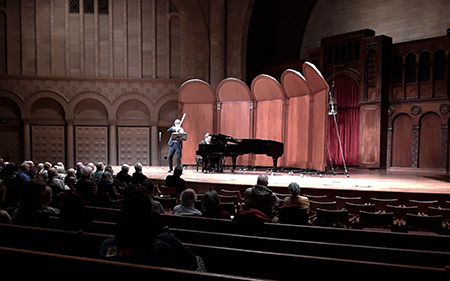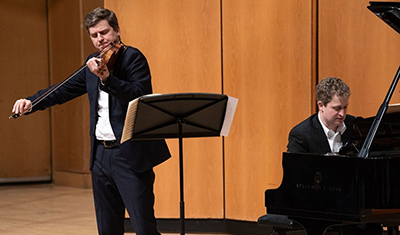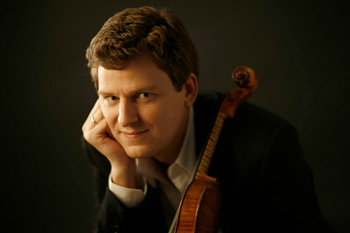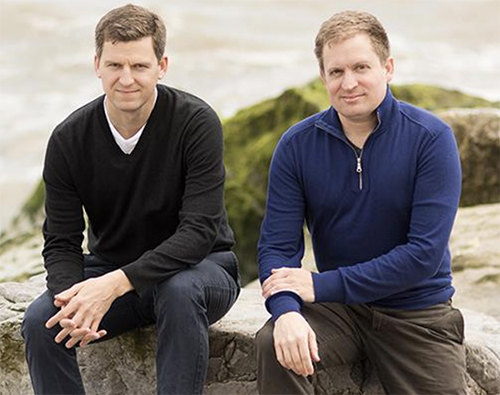by Daniel Hathaway

The Cleveland Chamber Music Society will take a bit of a different tack for its 70th Anniversary Season in 2019-2020. Violinist James Ehnes and pianist Andrew Armstrong will appear in three of the nine concerts, performing Beethoven’s complete Sonatas for violin and piano, a series that will be presented at the Maltz Performing Arts Center in University Circle on September 17, January 14 (pictured), and April 21.
As we now know, Ehnes and Armstrong had only completed two of their three programs before the novel coronavirus roared into town in March of 2020, causing widespread cancellations and postponements.
The final concert in their Beethoven series will now serve as the finale for CCMS’ 71st season on Tuesday, May 18 at 7:30 pm. The program includes Beethoven’s Sonata No. 8 in G, Op. 30, No. 3, Sonata No. 7 in c, Op. 30, No. 2, and Sonata No. 10 in G, Op. 96.
Tickets for the in-person concert at St. Paschal Baylon in Highland Heights are available online, and the Society is also offering a free live stream of the event.
Because so much time has passed since that September 2019 interview, and since the information remains relevant, we’re taking the liberty of reprinting that conversation.
Having reached James Ehnes at his home in Florida, I began by asking how the idea of performing all of Beethoven’s ten violin sonatas originated.

Then fate intervened. Ehnes and Armstrong once booked a studio in England to record a commissioned piece, but the work wasn’t ready yet. “The space, the recording engineer, and the producer were all on hold and we were faced with a whole day of dead time. What could we do to turn this into a useful day?”
Having played Beethoven’s “Kreutzer” Sonata quite frequently at the time, Ehnes proposed using that day to record it. “It’s never a bad idea to have a recording of the ‘Kreutzer,’ and we could figure out what to do with it later.”
“The composer snafu was a typical way for James to respond,” Armstrong said in a separate telephone conversation. “That recording project should have imploded at that moment, but he immediately pieced together in his mind how we could work really hard and really fast. I’m always thrilled when he invites me on one of those crazy rides.”
When the commissioned work was finished, they returned to record it, scheduling an extra day to record Beethoven’s Sixth Sonata. The two Beethoven sonatas eventually ended up on a critically-acclaimed CD. “Some publications assumed that this was the start of a cycle,” Ehnes said, and that prediction came true when the violinist was looking for a way to celebrate the 250th anniversary of the composer’s birth in 2020.
“Wouldn’t it be nice to finish recording the set and schedule performances of the cycle in places that are special to us?” Ehnes thought.
That might have qualified as another “crazy ride,” but Armstrong said he was “over-the-moon happy” when Ehnes proposed the project. “I so love the way he interprets Beethoven — the way he shares Beethoven. It’s been a great journey already, and it’s still going. Not every violinist performs all of these sonatas, and some are rarely programmed. The ‘Spring’ and the ‘Kreutzer’ are so popular. You’ll hear Opus 12, No. 3 sometimes, and the c-minor and G-Major Opus 32 and 33. But the Sixth Sonata, Op. 30, No. 1, is a masterpiece, and the a-minor, No. 4, is just unbelievable music. So one of the many great joys for me in this project is getting to present all ten sonatas. In fact, they’re all masterpieces. If you think that one is head and shoulders above the others, or not as good as the rest, you’re seeing something I’m unable to see.”

Armstrong added, “Just recently in Ottawa we played Nos. 1-5, took a day off, then played Nos. 6-10. That was a beautiful experience. And in Montreal, we played three nights in a row. That’s a fun journey for us and I think it can be really illuminating, culminating as it does in that incredible tenth sonata.”
However the concerts are organized, Ehnes and Armstrong are presenting the sonatas in near-chronological order. What can the performers and the audience learn about Beethoven from performing or hearing the pieces in such close proximity?
“My quartet is also doing a cycle of his string quartets,” Ehnes said, “but they cover a lot more stylistic ground and go a lot later. With the violin sonatas, you basically have a bunch of early sonatas, one incredibly great middle-period sonata, and then the very interesting tenth sonata, which is a turning point for Beethoven into a very different place. In a way, the conclusion of the cycle of violin sonatas is a launching point for where he went later. But certainly from a personal perspective, having spent all this time with the quartets, the sonatas, the great concerto, the triple concerto, and the romances, I begin to get an understanding of what he was trying to say at a particular time.”
For James Ehnes, the secret of understanding the sonatas is in the details, which he said seem inconsequential on their own, but when added up, become something important. “What is an interpretation other than a collection of a million little details informing a whole?” he asked. “It’s our hope that with every performance we give, we’re learning a little something new about the piece that we can add to our general understanding.”
Beethoven played both violin and piano, though he was more famous in his day as a pianist. I asked Ehnes how well his writing fits the violin?
“His writing is never easy even when it’s uncomplicated,” Ehnes said. “It’s by no means awkward, but it’s not idiomatic either. His violin writing requires a tremendous amount of precision that is made more difficult because the music has to be quite powerful and virtuosic. How to get that combination of swashbuckling on the one hand and extreme precision on the other?”

“A lot of times when there’ll be a break in a slur that’s very hard to pull off in a traditional way, James will just say, ‘Why don’t you make that a bow change? Don’t do a big lift in the slur, because in violin writing, that could just mean a bow change.’ Lo and behold, in many instances, that works beautifully. We really get deep into the weeds in our rehearsals, and we both have an inexhaustible appetite for details.”
Even if you don’t venture into the weeds, there are treasures to be found closer to the surface. The violin sonatas reflect a new aesthetic of beauty and lyricism that arose around 1800. “Certainly when you consider Beethoven’s music in general, there’s a great deal of beauty and friendliness in these pieces,” Ehnes said. “A couple of them are very stormy, but they’re immediately ingratiating and quite often extraordinarily beautiful. That makes them very rewarding to play and listen to.”
And Armstrong thinks there’s no better way to experience these pieces than through the lens of James Ehnes. “When James and I toured Canada, I had the experience of seeing his native land through a different prism — Canada through James, and James through Canada. Already the same effect is happening with the Beethoven project. Every day I feel I get a little closer to the flame through working with James.”
Published on ClevelandClassical.com May 12, 2021.
Click here for a printable copy of this article



